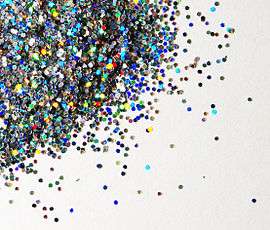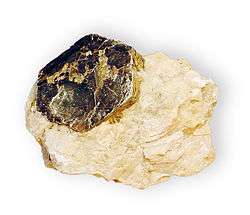Glitter
Glitter is an assortment of small, reflective particles that come in a variety of shapes and colors. Glitter particles reflect light at different angles, causing the surface to sparkle or shimmer. Glitter is similar to confetti, sparkles, or sequins, but somewhat smaller.

Since prehistoric times, glitter has been made from many different materials including stones such as malachite, and mica,[1] as well as insects[2] and glass.[3] Modern glitter is usually manufactured from plastic and is rarely recycled leading to calls from scientists for bans on plastic glitter.[4]
Modern glitter

The first production of modern plastic glitter is credited to the American machinist Henry Ruschmann, who found a way to cut sheets of plastic such as mylar into glitter in 1934.[1] During World War II, glass glitter became unavailable so Ruschmann found a market for scrap plastics, which were ground into glitter.[1][5] He founded Meadowbrook Inventions, Inc., in Bernardsville, New Jersey, and the company is still a producer of industrial glitter.[6] Decades later he filed a patent for a mechanism for cross-cutting films as well as other related inventions.[7]
Today over 20,000 varieties of glitter are manufactured in a vast number of different colors, sizes, and materials.[8] Over 10 million pounds (4.5 million kilograms) of glitter were purchased between the years of 1989 and 2009 alone.[9] Commercial glitter ranges in size from 0.002 to .25 inches (0.05 to 6.35 mm)[10] a side. First, flat multi-layered sheets are produced combining plastic, coloring, and reflective material such as aluminium, titanium dioxide, iron oxide, and bismuth oxychloride. These sheets are then cut into tiny particles of many shapes including squares, triangles, rectangles, and hexagons.[10]
Ancient glitter
Glittering surfaces have been found to be used since prehistoric times and the arts and in cosmetics. The modern English word "glitter" comes from the Middle English word gliteren, possibly by way of the Old Norse word glitra.[11] However, as early as 30,000 years ago, mica flakes were used to give cave paintings a glittering appearance.[1] Prehistoric humans are believed to have used cosmetics,[12] made of powdered hematite, a sparkling mineral.[13]
8,000 years ago people of the Americas were using powdered galena, a form of lead, to produce a bright greyish-white glittering paint used for objects of adornment.[14] The collecting and surface mining of galena was prevalent in the Upper Mississippi Valley region by the Cahokia native peoples, for regional trade both raw and crafted into beads or other objects.[14]
From 40,000 BC to 200 BC, ancient Egyptians, produced "glitter-like substances from crushed beetles"[15] as well as finely ground green malachite crystal. Researchers believe Mayan temples were sometimes painted with red, green, and grey glitter paint made from mica dust, based on infrared scans of the remnants of paint still found on the structures in present-day Guatemala.[16]
Uses
.jpg)

Prior to fabrics made with modern glitter, sequins were sewn or woven on to fabric to give it a glittering appearance. Edible glitter made from gum arabic and other ingredients is even used by culinary artists.[17]
Glitter is used in cosmetics to make the face and nails shiny or sparkly. Additionally, it is commonly used in arts and crafts to color, accessorise and texture items. The small, brightly colored particles often stick to clothing, skin, and furniture, and can be difficult to remove. It is also used on optically variable inks.
Glitter coatings or finishes are frequently used on fishing lures to draw attention by simulating the scales of prey fish.[18]
Due to its unique characteristics, glitter has also proven to be useful forensic evidence. Because of the tens of thousands of different commercial glitters, identical glitter particles can be compelling evidence that a suspect has been at a crime scene. Forensic scientist Edwin Jones has one of the largest collections of glitter consisting of over 1,000 different samples used in comparison of samples taken from crime scenes. Glitter particles are easily transferred through the air or by touch, yet cling to bodies and clothing, often unnoticed by suspects.[19]
Subculture
Glitter can be seen as a tool of fashion used by various subcultures, as it allows for a visible statement to be worn and seen on the body. This is because it has been theorized to be a "flickering signifier", or something that destabilizes known notions of popular culture, identity, and society.[20] Glitter is associated with "fringe cultures", which often use excessive glam and glamor such as glitter to evoke a deeper understanding between the relationships of commercialized popular culture and "high" culture, or "high-brow" art.[21]
Used by glam rockers, such as David Bowie, Gary Glitter, and Iggy Pop glitter is also used as a tool to help blur gender lines. This helped to create the more extreme "Glitter Rock" – an even more heightened version of glam rock.[22]
Glitter is also used by nail artists and make-up artists to make statements about femininity and beauty standards. The flashy, sparkling nature of glitter allows users to push standard ideas of beauty and what is and isn't considered "excessive" in terms of make-up. Glitter is usually associated with nightlife and not professionalism, but wearing it in different settings can push these boundaries.[20]
Glitter is also used for glitter bombing, which is an act of protest in which activists throw glitter on people at public events.[23] Glitter bombers have frequently been motivated by, though not limited to, their targets' opposition to same-sex marriage.[24] Some legal officials argue glitter bombing is technically assault and battery. It is possible for glitter to enter the eyes or nose and cause damage to the cornea or other soft tissues potentially irritating them or leading to infection,[25] depending on the size of the glitter. Whether a prosecutor would pursue the charges depends on a number of factors.[26]
Environmental Impact
Trisia Farrelly, an environmental anthropologist at Massey University, has called for a ban on glitter made of polyethylene terephthalate (PETE) and aluminium, as it is a microplastic that can break down into hormonal disruptors in the environment.[4] Furthermore, plastic glitter takes about one thousand years to biodegrade, according to Victoria Miller, a materials and engineering scientist at North Carolina State University.[27] When dozens of British music festivals pledged to ban single-use plastics by 2021, the proposed ban included plastic glitter.[28]
Biodegradable glitter made from eucalyptus tree extract is metaled with aluminium and can be coloured.[29] It is "40% softer and more delicate on the skin than conventional glitter," and it decomposes in soil or water.[28] Cellulose glitter is also available.[30]
According to Dr. Chris Flower, Director-General of the Cosmetic Toiletry and Perfumery Association, "the total contribution to marine plastic litter from glittery cosmetic products is negligible when compared to the damaging effects of bags and bottles... [The] total effect of giving up traditional glitter might not be great in comparison with other harmful plastics, we should still do everything we can."[31]
References
- Mangum, Aja (October 7, 2007). "Glitter: A Brief History". New York Magazine. Retrieved October 12, 2013.
- "Beauty, Hairstyles and Cosmetics in Ancient Egypt". Facts and Details. Retrieved November 12, 2012.
- Blumenthall, Deborah (March 3, 1988). "Restoring The Glitter And Sheen Of Jewelry". New York Times.
- Gabbatiss, Josh (November 16, 2017). "Glitter should be banned over environmental impact, scientists warn". The Independent.
- "All That Glitters: The History of Shiny Things". Etsy.com. Retrieved November 12, 2012.
- "Company Information". Meadowbrook Inventions, Inc. Archived from the original on September 27, 2013. Retrieved November 12, 2012.
- "Operating upon sheets of foil – US 3156283 A".
- "90 Seconds with Meadowbrook". Meadowbrook Inventions, Inc. Archived from the original on January 2, 2013. Retrieved November 12, 2012.
- Wagner, Sara (February 8, 2018). "Let's Talk About Glitter!". Cut to the Trace. Retrieved October 21, 2018.
- "Glitter and Sequins Sizing and Shaping". Meadowbrook Inventions, Inc. Archived from the original on September 27, 2013. Retrieved November 12, 2012.
- "Definition of GLITTER". www.merriam-webster.com. Retrieved March 30, 2017.
- "Neanderthal 'make-up' containers discovered". BBC News. January 9, 2010. Retrieved September 22, 2013.
- "The History of Glitter". Auntie Illumi. Archived from the original on December 5, 2012. Retrieved November 12, 2012.
- Gibbon, Guy E. (August 1, 1998). Ames, Kenneth M. (ed.). Archaeology of Prehistoric Native America: An Encyclopedia. Routledge. pp. 310. ISBN 978-0815307259.
- Sharma, Ruchira (November 17, 2017). "Where did glitter come from?". International Business Times UK. Retrieved October 21, 2018.
- Hansford, Dave (February 7, 2008). "Ancient Maya Used "Glitter" Paint to Make Temple Gleam". National Geographic. Archived from the original on June 6, 2013. Retrieved December 12, 2013.
- Weinberg, Caroline (February 14, 2018). "Should You Really Be Eating Edible Glitter?". Eater. Retrieved October 21, 2018.
- "Fishing lure – Patent US 2547240 A".
- Blackledge, Bob (2007). "Glitter as Forensic Evidence" (PDF). National Forensic Science Technology Center. Retrieved November 12, 2012.
- Michele, White. Producing women : the Internet, traditional femininity, queerness, and creativity. New York. ISBN 9781138776791. OCLC 889666420.
- Marchetti, Gina (December 1998). "Fringe cultures". Jump Cut (42): 58–60. Retrieved April 17, 2018.
- Bogdanov, Vladimir; Woodstra, Chris; Erlewine, Stephen Thomas, eds. (2002). All music guide to rock : the definitive guide to rock, pop, and soul (3rd ed.). San Francisco, CA: Backbeat Books. ISBN 087930653X. OCLC 49225452.
- Vinciguerra, Thomas (August 27, 2011). Glittering Rage. The New York Times
- Moody, Chris (June 20, 2011). "'Glitter advocates' plot their next victim". Yahoo! News. Archived from the original on June 24, 2011. Retrieved October 7, 2011.
- Kurtz, Judy (February 8, 2012). "Eye doctor warns of dangers of political protest on gay marriage". The Hill.
- van der Pool, Lisa (September 2, 2011). "All that glitters is not gold, in the eyes of legal system". Boston Business Journal. Archived from the original on September 29, 2011. Retrieved November 21, 2011.
- Weaver, Caity (December 21, 2018). "What Is Glitter?". The New York Times. ISSN 0362-4331. Retrieved January 1, 2019.
- Street, Chloe. "61 UK festivals are banning glitter - make the switch to eco sparkle". Evening Standard. Retrieved October 23, 2018.
- "The eco-friendly guide to glitter". BBC Newsbeat. November 18, 2017. Retrieved October 23, 2018.
- Bramley, Ellie Violet (January 21, 2018). "Losing its sparkle: the dark side of glitter". The Guardian. Retrieved January 26, 2019.
- Street, Chloe (April 16, 2018). "Could festivals ban glitter? Here's why it's time to switch to biodegradable sparkle". Evening Standard. Archived from the original on January 2, 2019. Retrieved January 1, 2019 – via MSN.
External links
| Wikimedia Commons has media related to Glitter. |
